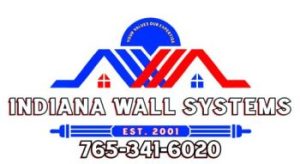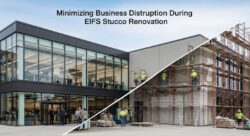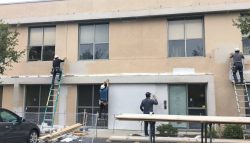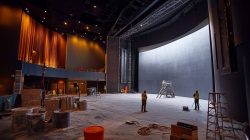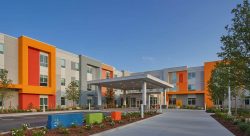How Indiana Businesses Use EIFS to Save Money and Stand Out
Have you noticed how many new buildings around Indiana are sporting clean lines and smooth finishes these days? That’s not just a design trend – it’s a practical choice that’s saving property owners serious money. As someone who’s spent over two decades installing EIFS (that’s Exterior Insulation and Finish Systems to newcomers), I’ve watched this material transform from a specialty option to the go-to choice for smart business owners and homeowners across central Indiana.
Whether you’re a property manager looking to slash energy costs, a business owner wanting to refresh your storefront, or a homeowner considering exterior options, today’s EIFS systems offer benefits that traditional cladding simply can’t match. And I’m not just saying that because I install it — the numbers speak for themselves!
Key Takeaways
- EIFS combines superior energy efficiency with design flexibility, making it ideal for both commercial buildings and modern homes
- Today’s drainage EIFS systems have resolved historical moisture concerns through advanced water management technology
- EIFS weighs only 1/10th as much as traditional stucco, reducing structural requirements and installation costs
- Commercial buildings with EIFS cladding can experience up to 30% energy savings compared to other exterior options
- EIFS gives businesses a competitive edge through custom branding opportunities and reduced maintenance costs
What Exactly Is EIFS? Understanding Synthetic Stucco
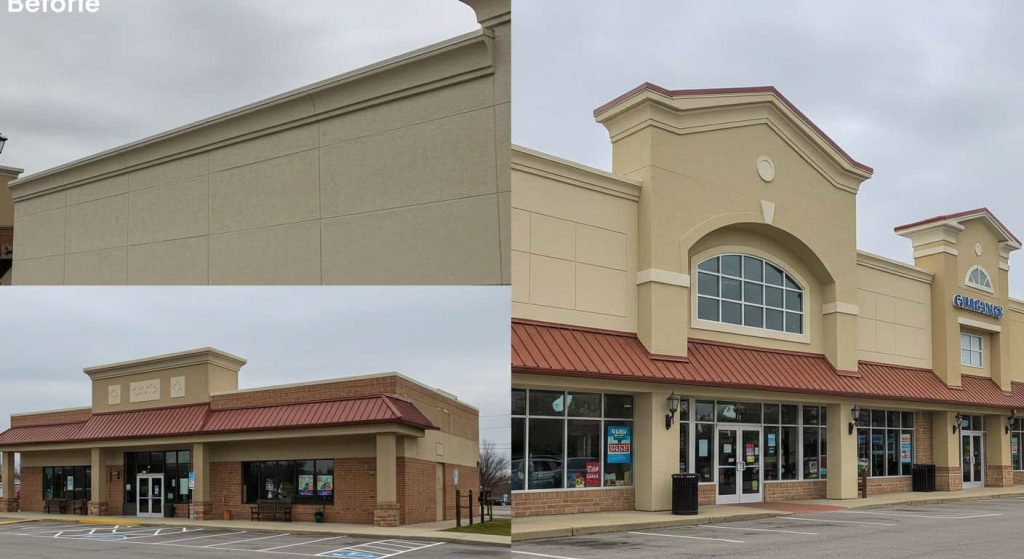
Let’s break down what we’re talking about here. EIFS, or Exterior Insulation and Finish System, is often called synthetic stucco because its final appearance resembles traditional stucco. But that’s where the similarities end.
Traditional stucco is a cement-based coating applied in three coats over metal lath. It’s heavy (about 8-10 pounds per square foot), brittle, and prone to cracking. It’s been around for centuries, and it works — but it has limitations.
EIFS, on the other hand, was developed in Europe after World War II as a way to efficiently rebuild and insulate buildings. It came to America in the 1960s and has evolved dramatically since then.
Modern EIFS is a multi-layered wall system that includes:
- A water-resistive barrier that protects the substrate
- Drainage plane for moisture management
- Insulation board (typically expanded polystyrene)
- Base coat reinforced with fiberglass mesh for impact resistance
- Finish coat available in countless colors and textures
Modern EIFS System Components
Modern drainage EIFS systems feature multiple water management layers for superior moisture protection.
The whole system weighs under 1 pound per square foot — a huge advantage when you’re covering large commercial facades.
What makes EIFS special is that it’s not just a decorative finish. It’s a complete continuous insulation system that wraps buildings in an energy-efficient blanket while giving architects almost unlimited design flexibility.
The Evolution from Basic EIFS to Modern Drainage Systems
EIFS has come a long way from its early days. If you remember hearing concerns about EIFS and moisture problems in the 1990s, you should know that today’s systems have completely addressed those issues.
Early EIFS was what we call a “barrier system” — it relied on the outer face to keep all moisture out. Modern EIFS uses a “drainage plane” design that acknowledges no cladding is perfect and provides pathways for any water that might get behind the finish to safely drain away.
As Jeff Johnson, I’ve installed both types, and the difference is night and day. Modern drainage EIFS is incredibly reliable when installed correctly. We test every installation with moisture meters to ensure performance, something that wasn’t standard practice 20 years ago.
Why Businesses Across Indiana Are Choosing EIFS
In my 22 years running Indiana Wall Systems, I’ve seen a massive shift in commercial construction. More and more businesses are choosing EIFS for their buildings, and it’s not just because it looks good. It’s a smart business decision driven by real numbers.
The Bottom-Line Benefits for Commercial Properties
Business owners care about ROI, and EIFS delivers. Here’s why commercial property owners from Indianapolis to Louisville are making the switch:
Energy Efficiency Translates to Real Savings
The continuous insulation provided by EIFS reduces thermal bridging — those pathways where heat escapes through studs and other structural elements. Traditional cladding systems can’t match this performance.
For commercial buildings, this means:
- Lower monthly operating costs — we’ve seen heating and cooling bills drop by 20-30% after EIFS installation
- Smaller HVAC requirements — new buildings can often install smaller, less expensive systems
- Meeting or exceeding commercial energy code requirements with less complexity
Let me share a quick example. We recently finished a 35,000 square foot office renovation in Carmel. The property manager called us after the first winter to report that their heating costs were down 26% compared to the previous year. That’s not unusual at all.
Annual Energy Savings With EIFS
Based on actual project data from central Indiana commercial installations by Indiana Wall Systems.
Design Flexibility Creates Brand Recognition
For retail and hospitality businesses, your building is part of your brand. EIFS gives architects and designers capabilities that no other cladding system can match:
- Custom shapes and details without expensive specialized labor
- Unlimited color choices that won’t fade or need frequent repainting
- Architectural elements like cornices, quoins, and reveal lines at a fraction of the cost of stone or precast
We worked with a hotel chain in Columbus, Indiana that used EIFS to include their signature wave motif across the building exterior. The same design in precast concrete would have cost three times as much and added significant structural requirements.
Durability Equals Lower Maintenance Costs
Business owners hate unexpected expenses. EIFS rarely needs repainting and doesn’t deteriorate like other claddings:
- Color goes all the way through the finish coat, unlike paint
- Elastomeric properties allow it to handle temperature shifts without cracking
- Impact-resistant mesh provides durability in high-traffic areas
One property manager in Indianapolis told me, “In 15 years, we’ve spent zero on exterior maintenance other than cleaning. Our competitor across the street has repainted twice and replaced rotted fiber cement three times in the same period.”
Commercial-Specific EIFS Applications
Commercial EIFS Projects by Building Type in Central Indiana
Based on Indiana Wall Systems commercial project distribution over the past 5 years.
Different businesses have different needs. Here’s how various commercial sectors are using EIFS:
Retail and Restaurants: Brand Identity and Energy Savings
Retail businesses are under intense pressure. Online competition means physical locations need to make an impression. EIFS helps by:
- Creating distinctive storefronts that attract customers
- Providing insulation for food service areas, reducing refrigeration costs
- Allowing for easy updates when rebranding without full tear-offs
Office Buildings: Tenant Comfort and Operating Costs
Office property managers compete for tenants based on amenities and operating expenses. EIFS delivers by:
- Improving occupant comfort with consistent interior temperatures
- Reducing common area maintenance charges that get passed to tenants
- Modernizing dated buildings without structural modifications
Hotels and Multifamily: Noise Reduction and Curb Appeal
The hospitality sector has unique challenges that EIFS addresses:
- Sound dampening between units or from exterior noise
- Design versatility to create high-end appearances on mid-range budgets
- Weather resistance for guest comfort in all conditions
Warehouses and Industrial: Quick Installation and Low Maintenance
Even industrial buildings benefit from EIFS:
- Fast installation means less downtime during construction
- Low maintenance equals more focus on core business activities
- Energy savings in large-volume spaces with high heating/cooling demands
EIFS vs. Traditional Materials: A Commercial Comparison
When business owners ask me about EIFS compared to other options, I like to break it down in terms they understand: initial cost, maintenance cost, and performance. Let’s compare EIFS to the most common alternatives for commercial buildings:
EIFS vs. Brick and Stone Veneer
Brick has been a commercial standard for generations. It’s solid and traditional. But how does it stack up against EIFS?
EIFS vs. Brick and Stone Veneer
| Factor | EIFS | Brick or Stone Veneer |
|---|---|---|
| Initial Cost | $9-14 per sq ft installed | $15-25 per sq ft installed |
| R-Value | R-4 to R-16+ (adjustable) | R-0.5 to R-1 (needs separate insulation) |
| Weight | 0.5-1 lb per sq ft | 35-45 lbs per sq ft |
| Design Flexibility | Unlimited shapes and colors | Limited by material constraints |
| Installation Time | 2-3 weeks for medium commercial | 4-6 weeks for same size |
| Maintenance | Minimal – occasional cleaning | Repointing every 25-30 years |
The numbers don’t lie – EIFS provides significantly better insulation at a lower cost with faster installation. That’s why we’ve seen so many businesses choose EIFS over brick, even in traditional markets like Indiana.
EIFS vs. Metal Panel Systems
Metal panels are popular for modern commercial designs. Here’s how they compare:
EIFS vs. Metal Panel Systems
| Factor | EIFS | Metal Panel Systems |
|---|---|---|
| Initial Cost | $9-14 per sq ft installed | $12-30+ per sq ft installed |
| R-Value | R-4 to R-16+ (adjustable) | R-0 (needs separate insulation) |
| Thermal Bridging | Minimal | Significant without modifications |
| Noise | Sound-dampening | Can be noisy during rain/hail |
| Design Options | Curves, details, textures | Limited to panel shapes |
| Maintenance | Minimal cleaning | Potential for dents, panel replacement |
Metal has its place, but when clients want both energy efficiency and design flexibility, EIFS usually wins on both counts.
EIFS vs. Fiber Cement
Fiber cement products have gained popularity for commercial applications. Here’s the comparison:
EIFS vs. Fiber Cement
| Factor | EIFS | Fiber Cement |
|---|---|---|
| Initial Cost | $9-14 per sq ft installed | $8-12 per sq ft installed |
| R-Value | R-4 to R-16+ (adjustable) | R-0.5 (needs separate insulation) |
| Weight | 0.5-1 lb per sq ft | 2.5-4 lbs per sq ft |
| Joints | Minimal or none visible | Visible joints between panels |
| Painting Required | No – integral color | Yes – every 7-10 years |
| Water Management | Modern systems include drainage | Relies on proper installation |
Fiber cement initially looks competitive on cost, but when you factor in the separate insulation needed and the ongoing painting requirements, EIFS is typically more economical over the building’s life span.
Understanding EIFS Performance in Commercial Settings
For business owners and property managers, performance metrics matter. Let’s look at how EIFS performs in commercial applications:
Energy Performance and Code Compliance
Modern commercial energy codes get stricter every year. EIFS helps buildings meet or exceed these requirements without complex wall assemblies:
- Continuous insulation satisfies ASHRAE 90.1 and IECC requirements
- Eliminates thermal bridging through structural members
- Adjustable R-value by simply varying insulation thickness
Most commercial buildings in Indiana now need to meet an R-value of R-15 to R-25 for wall assemblies. With EIFS, this is straightforward. With other claddings, it requires additional layers, expense, and complexity.
Fire Safety and Ratings for Commercial Buildings
Safety is non-negotiable in commercial construction. EIFS systems are tested and rated for fire performance:
- Most systems achieve NFPA 285 compliance for multi-story fire propagation
- Various assemblies offer 1-hour to 3-hour fire ratings when properly specified
- Non-combustible options available for sensitive applications
When properly installed by certified professionals (like our team at Indiana Wall Systems), EIFS meets all commercial building code requirements for fire safety.
Impact and Weather Resistance
Commercial buildings take abuse from weather, accidents, and everyday use. EIFS can be engineered for these challenges:
- Standard mesh provides good everyday durability
- High-impact mesh options for ground floors and high-traffic areas
- Panelized systems for areas needing extreme impact resistance
- Extreme weather resistance including hurricane ratings in coastal areas
In my experience, most commercial installations benefit from using high-impact mesh on the first 8-10 feet, with standard mesh above that height.
Water Management in Commercial EIFS Applications
Water management is critical for building longevity. Modern commercial EIFS includes advanced systems:
- Drainage planes that channel water out of the wall assembly
- Secondary water-resistive barriers to protect sheathing and structural elements
- Designed flashing integration at windows, doors, and transitions
- Vapor permeable options for different climate conditions
When properly installed, these systems have proven extremely reliable. In 22 years of installing and repairing EIFS in Indiana, I’ve seen that virtually all moisture problems come from improper installation, not system failure.
Case Studies: Indiana Businesses Benefiting from EIFS
Let me share some real examples from our commercial projects. Names have been changed for privacy, but these are all real central Indiana businesses that chose EIFS for their properties.
Hotel Renovation in Columbus: Energy Savings and Brand Update
Project Snapshot:
- 4-story, 120-room hotel built in 1985
- Previously clad with brick and EMAT stucco
- Needed updated appearance and energy improvements
EIFS Solution:
- 4″ EIFS system with drainage plane
- Custom architectural details to match brand standards
- High-impact mesh at ground level
Results:
- 28% reduction in heating and cooling costs
- Complete transformation of dated appearance
- Zero exterior maintenance in 5 years since installation
The property manager reports: “The EIFS installation paid for itself in under 4 years just in energy savings. The improved curb appeal has helped us maintain 12% higher occupancy than similar properties nearby.”
Office Complex in Carmel: Modernization with Minimal Disruption
Project Snapshot:
- 3-building office complex built in 1991
- Original exterior was precast concrete panels
- Poor insulation led to tenant complaints about comfort
EIFS Solution:
- 3″ EIFS over existing precast (no demolition required)
- Custom color scheme to complement surroundings
- Redesigned entry features for each building
Results:
- Installation completed while buildings remained fully occupied
- Tenant comfort complaints eliminated
- Property value increased by 15% according to next appraisal
The property owner told us: “We were able to increase rents by 8% after the renovation while actually lowering tenants’ overall occupancy costs due to the energy savings. It was a win-win.”
Retail Strip Center in Fishers: Attracting Premium Tenants
Project Snapshot:
- Single-story retail center with 12 tenant spaces
- Dated appearance with multiple vacant units
- High maintenance costs from frequent repainting
EIFS Solution:
- Complete redesign of façade with mixed finishes
- Creation of distinct storefronts for each tenant space
- Addition of architectural elements to break up flat appearance
Results:
- All vacant spaces leased within 3 months of completion
- Achieved 15% higher lease rates than pre-renovation
- Eliminated annual repainting budget
The owner’s feedback: “The EIFS renovation completely changed the caliber of tenants we could attract. We went from discount stores to boutique retailers willing to pay premium rates. The ROI was incredible.”
Best Practices for Commercial EIFS Installation
The key to successful EIFS performance is proper installation. After 22 years and countless commercial projects, I’ve learned what makes the difference between an average installation and an excellent one.
Substrate Preparation and System Selection
Before the first piece of insulation goes up, these steps are critical:
- Thorough substrate inspection for moisture, structural issues, or incompatibilities
- Proper system selection based on building use, climate, and performance requirements
- Integration planning with other building components (windows, doors, roofing)
- Mock-up creation to verify appearance and details before full installation
We recently worked on a warehouse conversion in Indianapolis where initial testing showed higher-than-ideal moisture content in the CMU substrate. By addressing this first and using a more vapor-permeable water-resistive barrier, we prevented future problems.
Critical Details for Commercial Durability
Commercial installations need special attention to these areas:
- Expansion joint placement to accommodate building movement
- Impact resistance zoning based on potential exposure to damage
- Termination details at grade, roof, and material transitions
- Proper sealant selection and installation for long-term waterproofing
One office building in Greenwood had to replace their EIFS after just 8 years due to improper expansion joints. The system couldn’t handle normal building movement, resulting in cracks and water intrusion. When we reinstalled with proper joints, the problem was eliminated.
Maintenance Recommendations for Business Owners
Once installed, EIFS requires minimal but specific maintenance:
- Annual visual inspections by maintenance staff or property managers
- Professional inspection every 3-5 years
- Prompt repair of any damage or sealant failure
- Regular cleaning according to manufacturer recommendations
Unlike many cladding systems, EIFS doesn’t require painting or extensive upkeep. A commercial client in Zionsville has maintained their EIFS-clad office building for 15 years with nothing more than occasional cleaning and minor sealant touch-ups.
Why Homeowners Are Following the Commercial Lead
While commercial buildings were early adopters of EIFS, homeowners are increasingly choosing this option for many of the same reasons. In central Indiana, we’re seeing more residential projects every year.
Crossover Benefits from Commercial to Residential
Homeowners are recognizing the advantages that businesses have enjoyed for years:
- Energy efficiency translates directly to lower utility bills
- Design flexibility allows for custom home aesthetics without custom prices
- Durability means less maintenance and longer intervals between updates
- Weather resistance is important for homes just as for commercial buildings
One homeowner in Carmel replaced their fiber cement siding with EIFS and reported a 24% reduction in winter heating costs the first year after installation.
Residential-Specific Advantages of EIFS
Beyond the commercial benefits, homes gain these additional advantages:
- Sound dampening from road noise or neighbors
- Design consistency across different architectural elements
- Seamless integration with stone, brick, or other accent materials
- Elimination of visible seams that detract from high-end appearances
For custom homes, EIFS allows luxury design elements like decorative cornices, columns, and archways at a fraction of the cost of traditional methods.
Real-World Examples: Indiana Homes Transformed by EIFS
Some of our most dramatic transformations have been residential projects:
- A 1970s ranch in Indianapolis gained a modern farmhouse appearance with architectural EIFS details
- A brick colonial in Zionsville added EIFS details that increased curb appeal and home value by over $45,000
- A new custom home in Fishers used EIFS to create a Mediterranean style that would have been cost-prohibitive with traditional materials
Common Questions About EIFS for Commercial Use
When business owners consider EIFS, they typically have several questions. Here are the ones I hear most often:
Does EIFS Hold Up in Indiana’s Climate?
This is perhaps the most common concern, and it’s a valid one. Indiana’s weather can be brutal – from sub-zero temperatures and ice storms in winter to 90°+ heat and high humidity in summer.
Modern EIFS is specifically engineered for these conditions. The acrylic polymers used in EIFS finishes maintain elasticity in extreme cold and resist UV degradation in summer heat. The insulation component helps buildings maintain consistent interior temperatures despite wild swings outside.
In our experience installing EIFS throughout central Indiana for over two decades, properly installed systems perform exceptionally well in our climate – often better than traditional materials that are more prone to freeze-thaw damage.
How Long Will a Commercial EIFS Installation Last?
Business owners need to understand their investment timeframe. While no exterior cladding lasts forever, EIFS has proven longevity:
- 25+ years for the finish coat before any significant fading or deterioration
- 40+ years for the reinforced base coat and insulation components
- Extended life through maintenance and occasional refreshing
We have commercial installations from the early 2000s that still look nearly new with just basic maintenance. Compare that to painted systems that typically need recoating every 7-10 years.
What About That Old Moisture Problem Reputation?
If you research EIFS, you might find old articles about moisture problems. This refers to issues in the 1990s with early residential barrier EIFS systems.
Today’s commercial EIFS systems use entirely different technology:
- Drainage planes that channel water out of the wall assembly
- Multiple moisture barriers to protect sensitive components
- Integrated flashings around openings and penetrations
- Regular testing during installation to verify performance
Modern drainage EIFS bears little resemblance to those early systems. Industry studies by EIMA (EIFS Industry Members Association) concluded that drainage EIFS actually outperforms most other cladding systems in moisture management when properly installed.
How Does EIFS Compare in Total Cost of Ownership?
Initial installation cost is only part of the equation. Smart business owners look at total cost over time:
- Initial installation: Typically $9-14 per square foot for commercial projects
- Energy savings: Often 20-30% compared to non-insulated systems
- Maintenance costs: Minimal – primarily inspection and occasional cleaning
- Replacement/repair: Less frequent than most alternatives
When calculated over a 30-year building lifespan, EIFS typically shows the lowest total cost of ownership among major cladding options.
Commercial EIFS Investment Recovery Timeline
Based on average commercial installation with standard energy costs. Actual recovery time varies by building size, usage patterns, and energy prices.
How to Choose the Right EIFS Contractor for Your Business
The quality of your EIFS installation depends heavily on the contractor you choose. Here’s what to look for:
Certifications and Experience Matter
Not all EIFS installers are created equal. Look for:
- Manufacturer certification from major EIFS manufacturers
- Specific commercial experience (commercial installations differ from residential)
- Longevity in business (EIFS is a specialty that requires years to master)
- Examples of similar projects in size and complexity to yours
At Indiana Wall Systems, we maintain certifications with every major EIFS manufacturer and have 160+ years of combined experience on our team. This depth of knowledge is what separates professional results from merely adequate ones.
Questions to Ask Before Hiring
When interviewing potential contractors, ask these key questions:
- “How will you handle the specific transitions on my building?” (Look for detailed answers)
- “What drainage details will you use at windows and penetrations?”
- “How will you test for moisture during and after installation?”
- “What warranty do you offer on materials and workmanship?”
- “Can I speak with commercial clients with installations over 5 years old?”
The answers will quickly reveal whether a contractor truly understands commercial EIFS installation.
Red Flags to Watch For
Be wary of contractors who:
- Offer significantly lower prices than other bidders (proper commercial EIFS installation has minimum cost floors)
- Cannot provide specific commercial references
- Propose unrealistic timelines
- Don’t discuss drainage and moisture management in detail
- Lack specific manufacturer certifications
Making the Decision: Is EIFS Right for Your Property?
So how do you decide if EIFS is the right choice for your commercial property? Here’s a framework to help:
Ideal Scenarios for Commercial EIFS Application
EIFS shines in these situations:
- Buildings with high energy costs that need improved efficiency
- Properties requiring visual updating without structural modifications
- Projects with complex architectural details that would be expensive in other materials
- Situations needing rapid installation to minimize business disruption
- Buildings where weight is a concern (retrofits, additions)
When Another Option Might Be Better
EIFS isn’t always the perfect choice. Consider alternatives when:
- Extreme impact resistance is needed at ground level (though EIFS can be used above)
- Historic preservation requirements mandate original materials
- Very high-traffic areas might be better served by masonry at the base with EIFS above
Getting Started: Next Steps for Interested Property Owners
If you’re considering EIFS for your commercial property:
- Consult with a certified EIFS professional for a property-specific assessment
- Request a detailed proposal outlining system components and installation methods
- Ask for energy modeling to estimate potential savings
- Review references and examples of similar projects
- Verify warranty terms for both materials and installation
Conclusion: The Future of Commercial Exteriors
The trend toward EIFS for commercial buildings isn’t just a passing fashion – it’s rooted in real performance benefits that directly impact business bottom lines. As energy codes continue to tighten and businesses look for ways to reduce operating costs, EIFS offers solutions that traditional cladding simply cannot match.
At Indiana Wall Systems, we’ve installed millions of square feet of EIFS on commercial properties throughout central Indiana over the past 22 years. We’ve seen firsthand how this versatile system transforms buildings – not just visually, but functionally.
The next time you’re driving through Indianapolis, Carmel, Fishers, or other central Indiana communities, take a closer look at those attractive modern buildings. Chances are, many of them are showcasing the benefits of EIFS – benefits your property could enjoy as well.
Ready to Explore EIFS for Your Property?
If you’re interested in learning how EIFS could benefit your specific commercial or residential property, we’re here to help. Indiana Wall Systems provides free consultations and estimates for properties throughout central Indiana.
Contact us at (765) 341-6020 or request a free estimate online to start the conversation about your building’s exterior possibilities.
Jeff Johnson is the CEO of Indiana Wall Systems, with 22 years in the EIFS business and 160 years of combined team experience. The company has designed and worked on projects ranging from 300,000 square foot commercial units to small residential repairs and restorations throughout Indiana, Kentucky, Ohio, Tennessee, Michigan, and Illinois.
